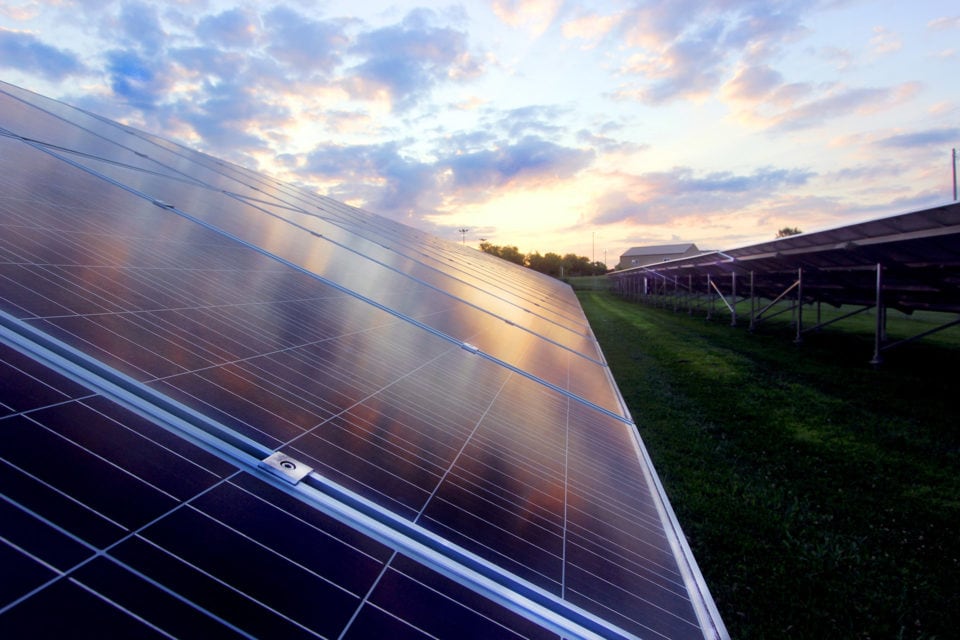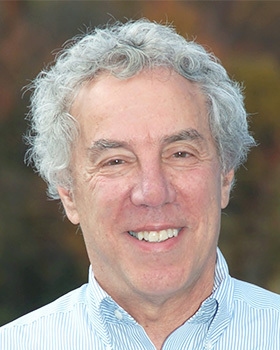Becoming More Aggressive: States Implement Ambitious Goals and Standards
By Warren Leon, Executive Director, Clean Energy States Alliance

Photo of industrial scale solar panels taken at dawn in Columbia, Missouri. Photo by Lucia Bourgeois.
Clean energy, economic development, and climate mitigation goals and targets can be important drivers of social change and market transformation. For state policymakers, having clear metrics can be a good way to know if they are making as much progress as expected. For decades, there have been various state goals related to clean energy, but many new and ambitious ones have been announced in recent years, often with considerable fanfare.
Part of the reason that states are setting more aggressive goals is the declining cost of clean energy technologies like wind, solar, and battery storage. This has made higher targets more achievable and less costly than previously assumed. Some governors and other state leaders have also embraced new targets knowing that bold policy actions are necessary to reduce the threat of catastrophic climate change. The main ways states have recently used goals and targets to drive clean energy deployments and expand markets are described below.
Renewable Portfolio Standards Become Stronger
A state renewable portfolio standard (RPS) requires electricity suppliers to get an increasing share or amount of their electricity from renewable energy and other clean energy technologies. RPSs, or similar policies under a different name such as a clean energy standard, have been established in 29 states plus the District of Columbia. They have probably been the single most important state policy mechanism for advancing clean energy. According to Lawrence Berkeley National Laboratory, non-hydro renewable energy capacity in the United States has generated 3,710,000 gigawatt hours (GWh) since 2000, with 45 percent of that being required by state RPSs. Although some of the RPS-required generation would likely have occurred without the RPS, there is no doubt that this has been a significant state policy to drive the growth of renewable energy generation. RPSs remain especially impactful outside the Great Plains region and Texas, where the favorable economics of wind energy enables large-scale development, largely without the financial incentives of an RPS.
A few years ago, it seemed like RPSs could be losing momentum, as some states were considering scrapping their RPSs or scaling them back. For example, in 2015, Kansas replaced its RPS with a voluntary renewable energy goal. But since then, only Ohio has weakened its RPS, while 14 states plus the District of Columbia have made significant increases to their RPSs, most often raising the near-term targets and creating new, higher, longer-term targets. In many cases, the final target year was pushed ahead from an original date of 2015–2022 to 2030 or later. Illinois did not change its RPS targets, but the 2016 Future Energy Jobs Act took other steps to make the RPS more effective and spur additional renewable energy development. As a result of these state actions, more than half of state RPSs have been significantly strengthened since 2015.
Admittedly, one of the reasons that only one state has weakened its RPS is because several states, such as Montana and Wisconsin, already reached their peak target, so there would be little practical impact of RPS-weakening legislative action. In those states, by not creating new RPS targets, the RPS has faded as a driver of renewable energy development. Nevertheless, the trend towards stronger RPSs is striking and notable. Many of the states have adopted very aggressive RPS targets, with nine states mandating at least 50 percent clean electricity; Hawaii and the District of Columbia now have targets of 100 percent renewable energy.
Although most of the RPS-strengthening actions were taken by states with Democratic governors and legislatures, there was often solid bipartisan support. For example, the Nevada RPS was increased by unanimous votes in both houses of the legislature. When Governor Steve Sisolak signed the legislation, he gave one of the pens used to the Republican Senate leader and remarked, “I’m joining leaders on both sides of the aisle to send a message to the country and the world that Nevada is open for business as a renewable leader, and our commitment to growing our clean energy economy will not falter or fade due to the political climate.”
States have also moved to make their RPSs more ambitious by adding new features. Following the lead of New Hampshire, several states —Maine, Massachusetts, and Oregon—expanded their clean energy standards to include renewable thermal technologies that generate heat rather than electricity. Vermont created a novel energy transformation tier to its renewable energy standard that requires retail electricity providers to reduce their customers’ fossil fuel consumption, whether or not the fuel is supplied by the utility.
Perhaps the most intriguing variant on an RPS has been the concept of a clean peak standard. Rather than simply adding more renewable energy into the electricity mix, a clean peak standard addresses the fact that electricity demand varies over the course of a day, with costs being much higher during times of greatest electricity use, i.e., during peak demand. A clean peak standard requires a certain amount of clean electricity to be produced during those times of high demand. In 2018, Massachusetts became the first state to establish a clean peak standard through legislation.
States Set Bold 100 Percent Goals
Over the past year, more states have established goals for moving towards 100 percent carbon-free or emissions-free electricity. In some cases, a state has set a general goal that does not necessarily establish the state’s RPS as the mechanism for achieving the goal; the state will later determine all the mechanisms for achieving the goal. Some of the states’ goals are enforceable, while others are not; for example, goals being expressed through a Governor’s executive order can be overturned or ignored by a future Governor. Fourteen states plus the District of Columbia now have a 100 percent goal in some form.
Energy Storage Gets its Own Mandates
As more electricity generation comes online from variable resources like solar and wind, it has become clear to the electricity industry and to state policymakers that much more energy storage will be necessary to ensure that electric capacity is available at the times it is needed, and that renewable energy generators are not curtailed at times when generation exceeds consumption.
California was the only state to require energy storage development before 2015. State legislators passed a law in 2010 directing the California Public Utilities Commission (CPUC) to open a proceeding to determine whether to mandate storage development and, if so, to set appropriate targets for procuring viable and cost-effective energy storage systems. As a result, the CPUC required the state’s three largest investor-owned utilities to procure 1.3 gigawatts (GW) of storage capacity by 2020. The CPUC set capacity targets for each utility, separate from the RPS. The targets were divided into sub-targets for storage connected at the transmission, distribution, and customer levels. Electric service providers and community choice aggregators also received mandates to purchase energy storage projects equal to one percent of their 2020 annual peak load, with installation and operation of the projects required by the end of 2024.
Other states have moved forward with storage requirements since 2015. In that year, Oregon passed a law that requires the state’s two largest utilities to procure “qualifying energy storage systems that have the capacity to store at least five megawatt hours (MWh) of energy.” A 2016 Massachusetts law required the Massachusetts Department of Energy Resources to study possible energy storage procurement targets and to implement them, if deemed appropriate. After analysis and a stakeholder engagement process, the Department adopted a target for electric distribution companies to procure 200 MWh of viable and cost-effective energy storage systems.
More recently, New Jersey and New York have come out with highly ambitious energy storage targets. In 2018, New Jersey passed a law that requires the state’s Board of Public Utilities to “initiate a proceeding to establish a process and mechanism for achieving the goal of 600 megawatts (MW) of energy storage by 2021 and 2,000 MW of energy storage by 2030.” New York’s energy storage roadmap included a target of 1,500 MW of storage by 2025. The Public Service Commission then made that an interim goal and added a further goal of 3,000 MW of storage by 2030, both of which Governor Cuomo codified with the signing of the Climate Leadership and Community Protection Act in July 2019.
These mandates have been important for commercializing energy storage technologies and building a market for them.
Making Solar the Standard for New Homes in California
Because of the tens of thousands of homes constructed each year in California, the California Energy Commission has long realized that it was important to include the new home market in the state’s strategies for transitioning to clean electricity. It offered financial incentives and conducted outreach to the building industry in order to encourage builders to incorporate solar photovoltaics (PV) into new home construction.
By 2018, the Energy Commission believed that the economics of solar were sufficiently favorable and the market was ready to meet a mandate for the inclusion of PV systems in new home construction, with a few exceptions. As of this year, the vast majority of new homes constructed in California are required to incorporate PV, either on the roof or in a community solar installation.
The blog post is adapted from CESA’s report “Returning Champions: State Clean Energy Leadership Since 2015.”
Photo Credit: Lucia Bourgeois via Flickr. CC by 4.0
Published On
March 2, 2020

